ArtistNicolas SCHÖFFER: Mayola (1958)



Nicolas SCHÖFFER
https://www.schoffergyujtemeny.hu/
Light is not just a privileged substance: it is an essential element. Without light there is no visual effect, no communication.
Mayola (1958)
Digital copy of a 35mm film
Directed by Henry Gruel, music by Tom Dissevelt
Born in Kalocsa, Hungary, Nicolas Schöffer worked in Paris from 1936 until his death and dedicated his life to creating an artistic medium that opened up the static three-dimensional sculptural form to the fourth dimension of time and movement. Drawing on the theories of circular causality, feedback, the self-regulation of open and closed systems, and information processing, he laid the foundations for cybernetic art, which he later sought to extend to the environment as an aesthetic experience for the organization of urban life. In 1948 Schöffer began to work on the concept of spatial dynamics, which made sculpture part of the virtual space, and from 1957 he constructed ‘luminodynamic’ sculptures (integrating light, music, and film) based on the idea of visually melting and evaporating the environment. From 1959 he assigned time and duration as starting points for his kinetic sculptures, which resulted in so-called „chronodynamic” works composed of parts that rotated on top of each other and emitted light according to a specific rhythm. Schöffer’s film Spatiodynamisme was shown at the 1958 World Exhibition in Brussels, and shortly afterward, with the support of the Philips company, he made the film shown here, which he created as a documentation of his experiments in light dynamics. The viewer is almost hypnotized by the incessant transformations of abstract color forms that constantly burst onto the screen, and the magic of the lyrical play of light, conceived as a chromatic vision, was even enhanced by the fact that Schöffer commissioned a pioneer of the fusion of jazz and electronic music, Tom Dissevelt, to accompany his optical play with the Dutch musician’s composition Orbit Aurora. Around the same time, Schöffer also created for Philips what is believed to be the world’s first cybernetic sculpture, CYSP 1 (1956), which included an electronic brain, and the sculpture interacted with the environment, taking into account the reactions of the viewer. For his efforts in exploiting the new aesthetic potential of cybernetic sculpture, the artist was awarded the Venice Biennale’s Grand Prize in 1968.

Nicolas Schöffer (b. Miklós Schöffer, 1912, Kalocsa – 1992, Paris) dedicated his life to creating an artistic medium that opened up the static three-dimensional sculptural form to the fourth dimension of time and movement, laying the foundations of cybernetic art, which he later tried to extend to the urban environment. In 1948 Schöffer began to work on the concept of spatial dynamics, which made sculpture part of the virtual space, and from 1957 he constructed „luminodynamic” sculptures (integrating light, music, and film) based on the idea of visually melting and evaporating the environment. From 1959 he assigned time and duration as starting points for his kinetic sculptures, which resulted in so-called „chronodynamic” works composed of parts that rotated on top of each other and emitted light according to a specific rhythm.
Light Revolution ExhibitionARTISTS
Zalán ADORJÁN | Gáspár BATTHA | Bálint BOLYGÓ | BORSOS LŐRINC | Éva BORTNYIK | Attila CSÁJI | Attila CSÖRGŐ| Ben FODOR| GLOWING BULBS | Zsolt GYENES | HEALIUM | Tamás HERCZEG | Erzsébet HORVÁTH | György KEPES | Gábor KITZINGER| Ivó KOVÁCS | Éva KÖVES | Waldemar MATTIS-TEUTSCH | András MENGYÁN | László MOHOLY-NAGY | Erik MÁTRAI | András NAGY | Nicolas SCHÖFFER | Zalán SZAKÁCS | Ariel Dávid SZAUDER | Csongor G. SZIGETI | Csilla SZILÁGYI | Jeannette SZIRMAY | Andrea SZTOJÁNOVITS | Róbert TERKÁL | Csaba TUBÁK | Victor VASARELY | Viktor VICSEK | Ákos ZEMBA
